#Oxycirrhites
Text

Longnose hawkfish (Oxycirrhites typus) in Seafan coral
Photo by Georgette Douwma
#Oxycirrhites typus#Oxycirrhites#sea fan#coral#cnidaria#hawkfish#fish#red#red fish#red coral#coral reef#reef#marine#marine animals#marine life#ocean#sea#nature#animals#wildlife
314 notes
·
View notes
Text

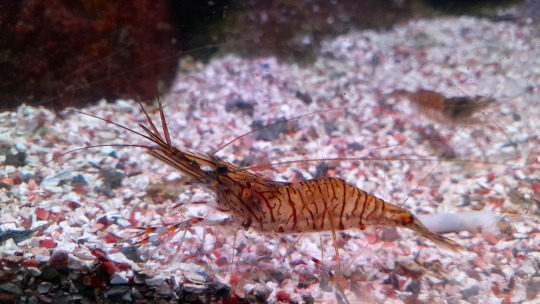
shrimp & shrimp-coded fish
Aquarium de Paris, 2023
EDIT: Thanks b0chelly for the ID: it's a longnose hawkfish
27 notes
·
View notes
Photo
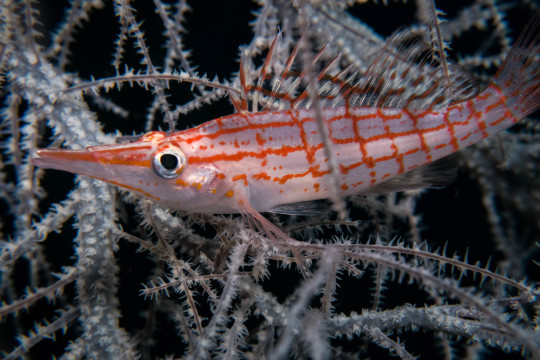
Longnose hawkfish (Oxycirrhites typus)
82 notes
·
View notes
Text
The most curious of the hawkfishes, Oxycirrhites
The longnose hawkfish (Oxycirrhites typus) is a distinctive member of the cirrhitid or hawkfish clade, and is widely distributed in the Indian and Pacific oceans, at warmer latitudes. This is, for many people, "the" hawkfish species that springs to mind, but it is actually an unusual outlying species among its clade, because only Oxycirrhites has the long jaws. The species grows to 13 centimeters, or slightly over 5 inches long, and perches among the large gorgonian and antipatharian colonies, that grow on the steep outer reef slopes, over 25 meters deep, where the current is strong. Like other hawkfishes, Oxycirrhites lacks a swim bladder, and sits on a substrate, waiting for passing items. This fish is territorial to its own species, and primarily consumes small arthropods. It has large eyes, and is adapted to life in low light conditions.
In the aquarium, Oxycirrhites may pose a danger to small, motile animals, such as "nano" gobies, molting hermit crabs, fan worms that have evacuated their tubes, and very small ornamental shrimp. However the jaws are gracile, and not constructed to struggle with proportionally large prey. Most ornamental reef species, will not fit in the narrow maw of Oxycirrhites, and it will not regard them as prey animals. Downsides arise from the typical, hawkfish perching habits of Oxycirrhites, as it may fall prey to stinging corals and anemones, or irritate a colony that it opts to perch upon regularly. Fortunately, when in the absence of such cnidarians in the aquarium, and in the presence of strong lighting, Oxycirrhites will instead roost in a grotto, or under an overhang. Oxycirrhites consumes finely chopped fresh seafood, defrosted aquarium fare, and sometimes even dried, proprietory preparations. This species is not a typical hawkfish in all ways, but it is a perfect example of that clade, in others. And its preference for only small prey mean that Oxycirrhites is, at least, the least problematic of the traded hawkfishes to care for, in a reef or fish-only marine aquarium.
0 notes
Text
Final Major Project (FMP)
Corals & Anemones (Part 1)
Many people mistake corals and anemones for plants, but they are in fact animals. They are members of the cnidaria, an ancient and simple group of animals. Jellyfish are also included in this category. These creatures have a symmetrical body, usually with stinging tentacles, and a central mouth. A coral structure is actually made up of hundreds or thousands of these tiny animals growing in colonies. The coral reef is built by these tiny coral polyps. Their tiny calcium shells have built up over thousands of years to form the world's largest living structures. The majority of cnidaria live in colonies, but a few, such as jellyfish, swim free. To catch their prey, most of these animals use stinging cells called nematocysts. Some of them, particularly jellyfishes, can inflict extremely painful stings on humans. The anemones are well known for forming symbiotic relationships with clownfish members. This is a unique living arrangement in which both animals help each other. The anemone protects the clownfish, and the clownfish, in turn, provides food for the anemone. The following is a list of some of the more common cnidaria members.
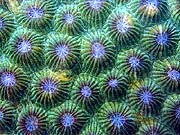
Pineapple Coral
(Montastrea cavernosa)
Photo © Aris Entertainment
The pineapple coral is a type of coral with small polyps that form flat, honeycomb patterns. The colony as a whole is shaped like a large dome. Polyps are typically green or brown, but can also be red or orange. They feed by extending their delicate, translucent tentacles at night.
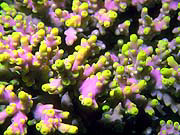
Staghorn Coral
(Oxycirrhites typus)
Photo © IMSI
The staghorn coral is a hard coral species that forms a branching structure resembling the horns of stag deer. The colonies are usually golden-brown with pale tips, but can also range from blue to pink, purple, orange, green, and yellow. This coral is common throughout Caribbean region.

Brain Coral
(Diploria strigosa)
Photo © Aris Entertainment
Brain corals come in a variety of shapes and sizes and can be found all over the world. The brain-like ridges that cross their surface give them all their names. The smooth brain coral grows in a large dome-shaped structure that is approximately 4 feet in diameter. It is a widespread species in the Caribbean, ranging from Florida to the Bahamas.

Torch Coral
(Caulastrea furcata)
Photo © IMSI
The torch coral is a beautifully colored species with a candy-like appearance. In fact it is also known as the candycane coral. The polyps are brown with yellow stripes, and their insides are neon green. They are often found in small, tight clusters. This coral is nocturnal. It extends its delicate tentacles to feed at night.

Star Coral
(Galaxea fascicularis)
Photo © Aris Entertainment
The star coral is one of the hard coral species that contains a stone-like calcium skeleton. Small, oval stubs rise from the yellowish-tan central core, each containing a delicate white star-shaped polyp. The Star Coral is commonly found throughout the Caribbean and the West Indies, and usually grows to about 12 inches in height.

Cup Coral
(Turbinaria reniformis)
Photo © IMSI
The cup coral is a hard coral species that grows in a variety of shapes. The hard coral skeleton is covered with small bumpy growths. Delicate flower-like polyps emerge when the coral is feeding. This coral is usually found in colors ranging from yellow to purple, gray, green, and brown. It is found throughout the Indo-Pacific region.

Sun Coral
(Tubastrea aurea)
Photo © Hammerhead Interactive
This beautiful orange and yellow hard coral prefers dark locations, and can be found lining the mouths of submarine caves and crevices. They usually have a bright orange, stony base with colorful yellow polyps. This coral is common throughout the reefs of the Indo-Pacific region.

Bubble Coral
(Plerogyra sinuosa)
Photo © Aris Entertainment
The bubble coral is a curious looking species. It has rounded, bubble-like polyp vesicles that expand during the day. These bubbles are used to collect light, which is essential for the coral's growth. At night, the polyp tentacles expand for feeding. The bubble coral is common throughout the Indo-Pacific region and Australia.
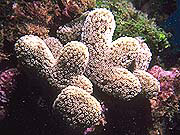
Clubbed Finger Coral
(Porites porites)
Photo © IMSI
The clubbed finger coral is a common species throughout the coral reefs of the Caribbean and the Gulf of Mexico. The polyps have long flower-like tentacles that grow in thick clumps. The colony forms long branches, which are swollen on the ends. These branches usually reach a length of about 12 inches.
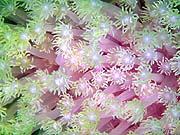
Flowerpot Coral
(Goniopora lobata)
Photo © IMS
The flowerpot coral is one of the most beautiful coral species. It has a hard dome-shaped base from which emerge hundreds of delicate flower-like tentacles. The tentacles wave in the currents, and are green in color due to the presence zooxanthellae algae. This coral is common throughout the Indo-Pacific region.
0 notes
Photo

19 notes
·
View notes
Photo

08.10.17
Langnasen Korallenwächter / Longnose hawkfish / Oxycirrhites typus / Carless Reef - Red Sea / Aquarius Diving Club
#Langnasen Korallenwächter#longnose hawkfish#oxycirrhites typus#carless reef#red sea#aquarius diving club#scuba#scuba diving#diving#Tauchen#underwater#Unterwasser#plongée#duiken#sea#mer rouge#sea life#marine life#ocean#Ägypten#Egypt
7 notes
·
View notes
Photo

Longnose hawkfish (Oxycirrhites typus)
68 notes
·
View notes
Photo
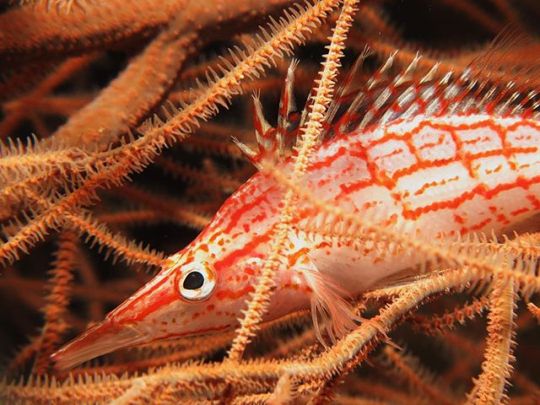
Oxycirrhites typus Kaafu Atoll Canon G10 (2009) #underwaterphotography #marineanimals #fishphotography #maldives #macrophotography #naturephotography #longnosehawkfish #tropicalfish #scubadiving #marinephotography #reefphoto — view on Instagram https://ift.tt/2Hs4P3W
1 note
·
View note
Photo

"Perched in the gorgonians". A longnose hawlfish (Oxycirrhites typus) perches gingerly in a gorgonian sea fan (Muricella plectana). Komodo National Park, Indonesia. Jul 2018. [Canon 5D m3] — view on Instagram https://scontent.cdninstagram.com/vp/dd8f7b8584708a3fd55e7020057e2e7b/5C501FBA/t51.2885-15/sh0.08/e35/s640x640/42655766_2406571022693509_1916147733385245049_n.jpg
0 notes
Photo
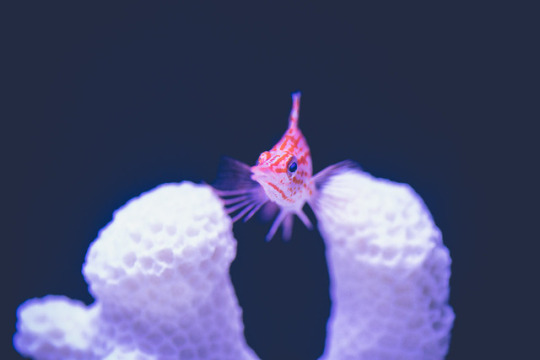
6 notes
·
View notes
Photo

16.04.17
Langnasen Korallenwächter / Longnose hawkfish / Oxycirrhites typus / Umm Kamar - Hurghada - Red Sea / Aquarius Diving Club
#Langnasen Korallenwächter#Longnose hawkfish#Oxycirrhites typus#Umm Kamar#Hurghada#red sea#aquarius diving club#scuba diving#diving#Tauchen#underwater#Unterwasser#sea#sea life#marine life#Ägypten#Egypt#Korallen#corals#barsch#Grouper
2 notes
·
View notes
